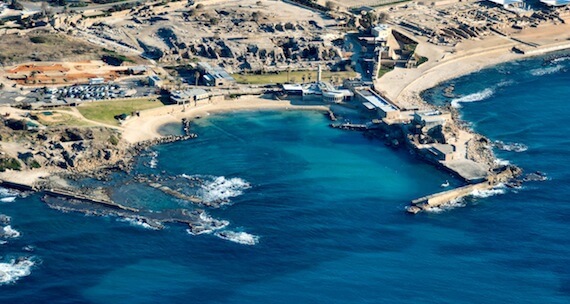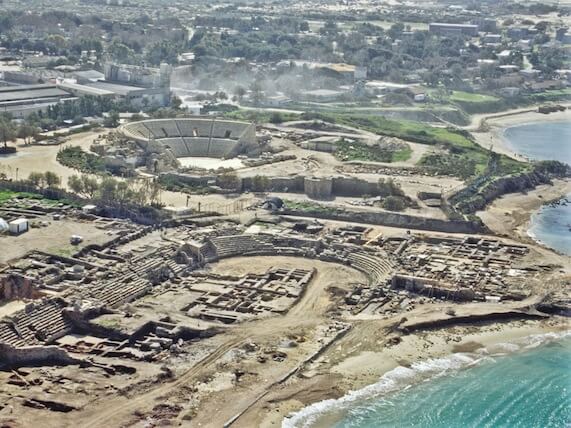People had money to burn in Caesarea. As one of the largest seaports on the eastern Mediterranean—and located along the International highway—Caesarea enjoyed a constant flow of people and commerce.

(Photo: Caesarea’s Ancient Harbor. Courtesy of the Pictorial Library of Bible Lands)
The bustling seaport featured all the usual touches of Roman culture—including a vast entertainment industry for the masses that frequented the city.
This hub of transportation became the means by which people received more than a good show.
They received good news.
Good Show—A Place for Entertainment
Caesarea had an immense amphitheater and hippodrome that could accommodate well over 10,000 spectators for sporting events and chariot races (think Ben Hur).
- Over the centuries, the ocean has battered the seaside hippodrome so much that the western portion of the complex has completely washed away.
- Similarly, a storm in December of 2010 did costly damage to Caesarea, a testimony to how the much of the site has crumbled into ruins over the centuries.

(Photo: Caesarea amphitheater and theater, courtesy of Pictorial Library of Bible Lands)
A massive theater for 3500 spectators overlooked the ocean. The setting sun over the sea would have provided a marvelous backdrop for theatrical performances. Today’s restored theater still offers a popular venue for concerts in Israel.
- According to the Jewish historian, Josephus, the “theater” gave stage to the agonizing death of Herod Agrippa I (Antiquities XIX.8.2). However, it’s possible that Josephus refers to Agrippa’s death in the amphitheater/hippodrome, rather than in the theater.
- Agrippa stood to address the throng that gathered there and that hailed him as a god, and the Lord struck him down because he did not give glory to God (see Acts 12:20-23).
(Google Street View: Explore Caesarea’s Hippodrome)
During the first Jewish Revolt, the Roman General Titus—who leveled Jerusalem’s temple in AD 70—forced 2500 Jews to combat wild beasts in Caesarea’s amphitheater.
During the second Jewish Revolt, the Rabbi Akiva was executed in Caesarea along with his disciples and other Jewish captives. The state-of-the-art Visitor’s Center next to the ancient harbor tells Rabbi Akiva’s story.
Good News—A Place for Evangelism
Caesarea also played a prominent role in the history of Christianity.
- Philip the Evangelist settled in Caesarea (Acts 8:40; 24:8).
- The Apostle Peter traveled here to share the message of Jesus’ death and resurrection with a Roman Centurion named Cornelius (Acts 10-11).
- As mentioned in last week’s post, the Apostle Paul found himself imprisoned at Caesarea for two years, and from Caesarea’s port Paul embarked on his death-defying sea voyage to Rome (see Acts 26-28).
on my upcoming trip to Israel.
See the details, browse the tour itinerary, and
download a FREE brochure! After your journey to Israel,
you will never be the same!
A Good Book—A Place for Historical Geography Education
In the third century, Origen of Alexandria moved to Caesarea and explored biblical sites in order to better understand the Scriptures.
Eusebius of Caesarea, a pupil of Origen, wrote the first historical geography of Bible lands. You can still get a copy today, finally in English.
- Having lived in what was then called “Palestine” all his life, Eusebius was suited to the task of writing his Onomasticon (“a collection of names”) around A.D. 325.
- Without this volume, we would not know the location of many biblical sites.
- Eusebius recognized the value of geography to biblical studies, and he systematized his book—a venerable index and encyclopedia of sites and locations—for Bible students who may never see the land itself.
- Eusebius’ Onomasticon did much to set in motion early pilgrimages to the Holy Land.
(Google Street View: Explore Caesarea’s restored theater)
Caesarea—Still a Place of Entertainment, Evangelism, and Education
Even today, with more than one million visitors a year, Caesarea National Park remains a great place to entertain people with money to burn. But the many tourists who come here also hear of Philip, Peter, and Paul—whose legacy continues to make Caesarea a place of education and evangelism.
More than a good show, Caesarea still is a place of good news.
